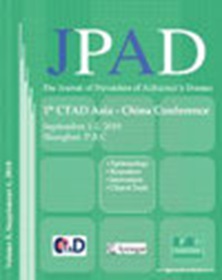血浆MMP-9水平与apoe4阳性MCI患者转化为痴呆的未来风险:基于阿尔茨海默病神经影像学倡议数据库的调查
IF 7.8
3区 医学
Q1 CLINICAL NEUROLOGY
引用次数: 0
摘要
已有报道称基质金属蛋白酶9 (MMP-9)与apoe4阳性MCI患者海马体积和认知功能下降有关。目的探讨血浆基质MMP-9对携带和不携带ApoE4的轻度认知障碍(MCI)患者转化风险的影响。设计和设置回顾性观察研究,数据提取自阿尔茨海默病神经影像学倡议数据库。我们纳入了211例ApoE4阳性MCI (ApoE4+ MCI)和184例ApoE4阴性MCI (ApoE4-MCI)。我们获得了人口统计学数据,包括基线血浆MMP-9水平和临床痴呆评分(CDR)长达15年的纵向变化。我们通过Log-rank检验比较ApoE4+ MCI和ApoE4- MCI之间的转化率,并使用ApoE4+ MCI和ApoE4- MCI的多重Cox回归分析计算协变量的风险比(HR),包括年龄、性别、受教育程度、饮酒和吸烟史、药物和血浆MMP-9水平。结果ApoE4+ MCI组与ApoE4- MCI组血浆MMP-9基线水平无显著差异。在ApoE4+ MCI中,高血浆MMP-9水平显著高于低血浆MMP-9水平(HR, 2.46 [95% CI, 1.31-4.48])和中血浆MMP-9水平(HR, 1.67 [95% CI, 1.04-2.65]),但在ApoE4- MCI中无此差异。结论:血浆MMP-9可能是ApoE4+ MCI患者未来转化为痴呆的风险因素。本文章由计算机程序翻译,如有差异,请以英文原文为准。
Plasma MMP-9 Levels as the Future Risk of Conversion to Dementia in ApoE4-Positive MCI Patients: Investigation Based on the Alzheimer’s Disease Neuroimaging Initiative Database
Background Matrix metalloproteinase 9 (MMP-9) has been reported to be correlated with declines in hippocampal volume and cognitive function in ApoE4-positive MCI patients. Objectives The present study was aimed to investigate the effects of plasma matrix MMP-9 on the conversion risk between mild cognitive impairment (MCI) patients with and without ApoE4. Design and Setting Retrospective observational study using the data extracted from the Alzheimer’s Disease Neuroimaging Initiative database. Participants We included 211 ApoE4-positive MCI subjects (ApoE4+ MCI) and 184 ApoE4-negative MCI subjects (ApoE4-MCI). Measurements We obtained demographic and data including plasma MMP-9 levels at baseline and longitudinal changes in Clinical Dementia Rating (CDR) up to 15 years. We compared conversion rates between ApoE4+ MCI and ApoE4- MCI by the Log-rank test and calculated the hazard ratio (HR) for covariates including age, sex, educational attainment, drinking and smoking histories, medications, and plasma MMP-9 levels using a multiple Cox regression analysis of ApoE4+ MCI and ApoE4- MCI. Results No significant differences were observed in baseline plasma MMP-9 levels between ApoE4+ MCI and ApoE4- MCI. High plasma MMP-9 levels increased the conversion risk significantly more than low plasma MMP-9 levels (HR, 2.46 [95% CI, 1.31–4.48]) and middle plasma MMP-9 levels (HR, 1.67 [95% CI, 1.04–2.65]) in ApoE4+ MCI, but not in ApoE4- MCI. CONCLUSION: Plasma MMP-9 would be the risk of the future conversion to dementia in ApoE4+ MCI.
求助全文
通过发布文献求助,成功后即可免费获取论文全文。
去求助
来源期刊

Jpad-Journal of Prevention of Alzheimers Disease
CLINICAL NEUROLOGY-
自引率
7.80%
发文量
85
期刊介绍:
The JPAD « Journal of Prevention of Alzheimer’Disease » will publish reviews, original research articles and short reports to improve our knowledge in the field of Alzheimer prevention including : neurosciences, biomarkers, imaging, epidemiology, public health, physical cognitive exercise, nutrition, risk and protective factors, drug development, trials design, and heath economic outcomes.
JPAD will publish also the meeting abstracts from Clinical Trial on Alzheimer Disease (CTAD) and will be distributed both in paper and online version worldwide.
 求助内容:
求助内容: 应助结果提醒方式:
应助结果提醒方式:


